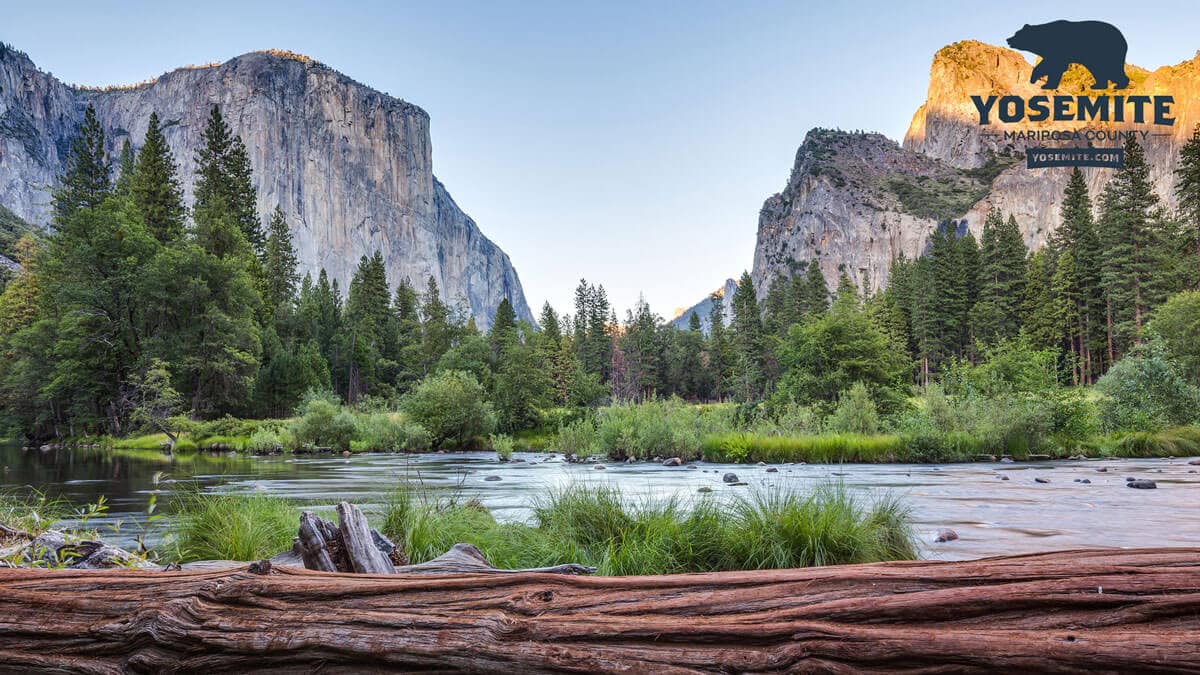Yosemite National Park is one of America’s most revered wilderness sanctuaries. From the soaring symphony of Yosemite Valley to the giant sequoias of Mariposa Grove, awesome scenic overlooks, and waterfalls everywhere, the sheer beauty of the Park can be as staggering as its size: 1,200 square miles of breathtaking natural terrain.
Our Yosemite First-Timer itinerary packages the Park’s must-see places and areas for newcomers to this majestic realm. The order of days can be shuffled based on your preferences and external factors such as weather – once you’re in Yosemite Mariposa County, most everything is a short drive away.
Day 1: Yosemite Valley & Glacier point
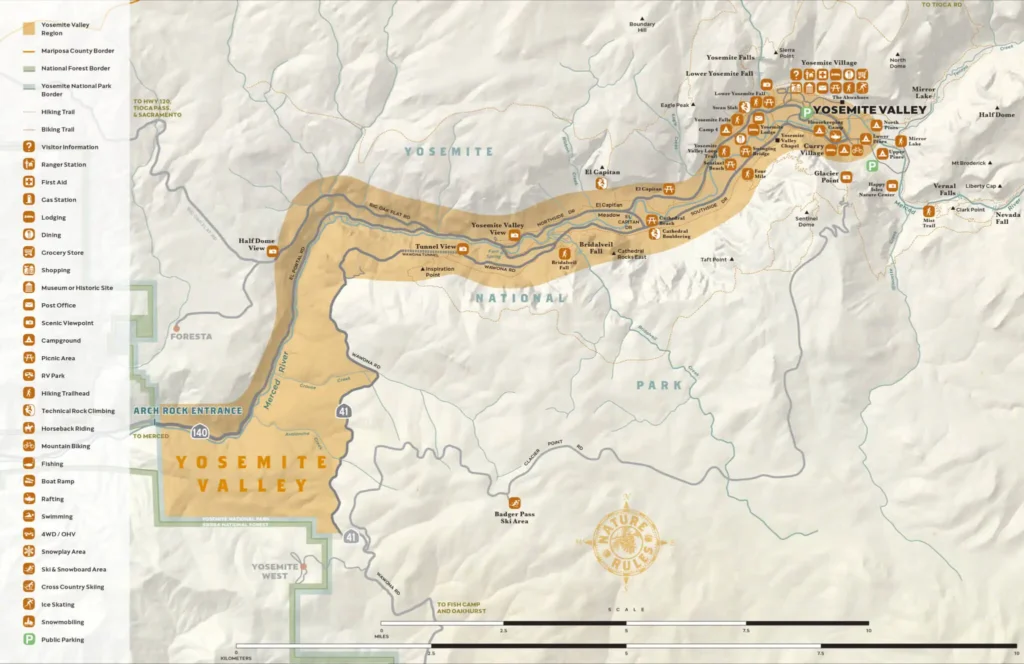
The best place to kick off your first tour: Yosemite Valley, the heart of the Park. The waterfalls, granite cliffs, and expansive meadows of Yosemite Valley endow Yosemite National Park with worldwide acclaim. Prepare to be awestruck!
Enter the Valley via the Wawona Tunnel and take a moment to stop at Tunnel View, where El Capitan, Half Dome, Clouds’ Rest, and Bridalveil Fall fill the horizon. (And chalk up a bonus badge: you just drove through the longest highway tunnel in California.)
Now it’s time to feel the cooling mist of one of Yosemite’s signature attractions: waterfalls. Drop into the Valley and take a short morning hike to the base of Bridalveil Fall, one of the most accessible big falls in Yosemite. This is the grand waterfall that you see from Tunnel View, and it’s even more dramatic up close. The new viewing platform, parking lot, and visitor amenities make this a must-see.
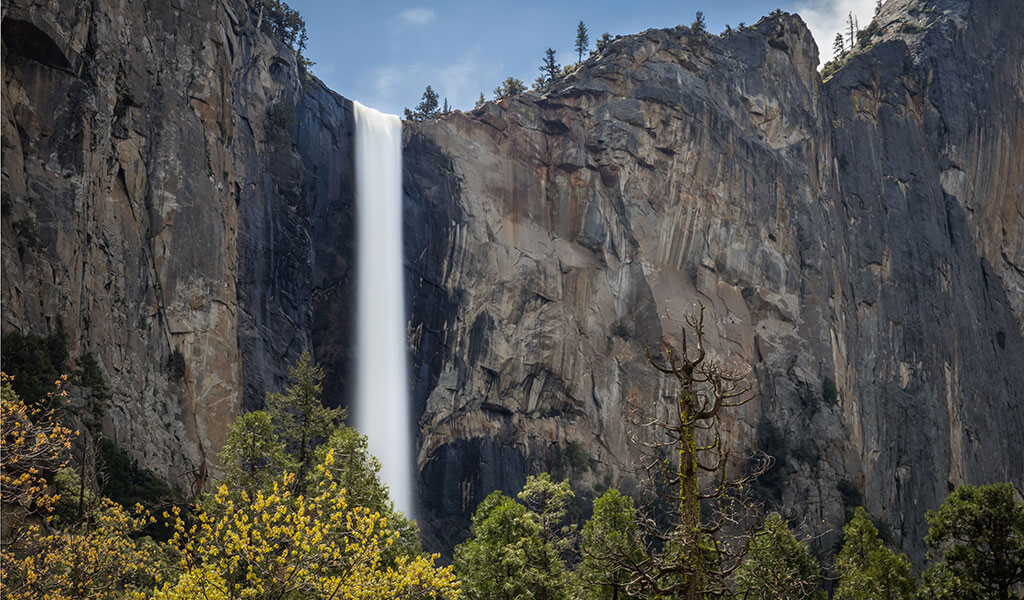
Continue on Southside Drive and loop around the valley to Northside Drive for another short hike with an enormous payoff: Lower Yosemite Fall. Pro challenge: if you’re all in for getting to the top of North America’s tallest waterfall, the 7.5-mile round trip to Upper Yosemite Falls is a full-day trail experience that climbs nearly 2,500 vertical feet up the waterfall’s plummeting path with oohs and aahs all along the way.
Make yourself a Yosemite insider by taking the Valley Loop Trail, a hidden-in-plain-sight path that hugs the base of Yosemite Valley’s granite walls for 13 miles. Many sections of the relatively hidden trail are flat-out breathtaking (not to mention, literally flat) – the Pohono Bridge to Cathedral Rocks is one stretch not to miss.
After a morning of Valley majesty, break for lunch at one of the cafes and restaurants in Curry Village. The afternoon holds more aquatic and geologic splendor with hiking options including the famous Mist Trail to Vernal and Nevada Falls and the classic Mirror Lake Trail for up-close Half Dome views.
If your daily step count is eclipsed, or the weather’s better suited for an afternoon indoors, check out the Ansel Adams Gallery, a treasure box of the famed photographer’s iconic Yosemite works (as well as one of the best gift shops in the Park).
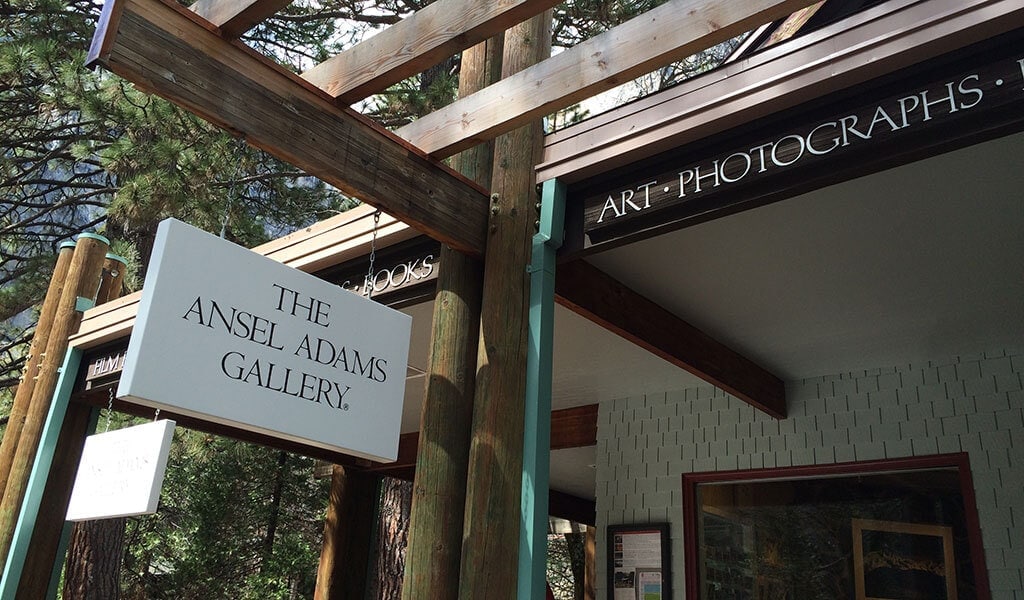
After this epic full-day intro to Yosemite National Park, you’ll be ready to repair to your hotel, campsite, or vacation rental for refreshment, dinner, and a good night’s sleep!
Expand your horizon by exploring Yosemite’s vast panorama of soaring peaks, crystal-clear lakes, and wildflower-dotted meadows.
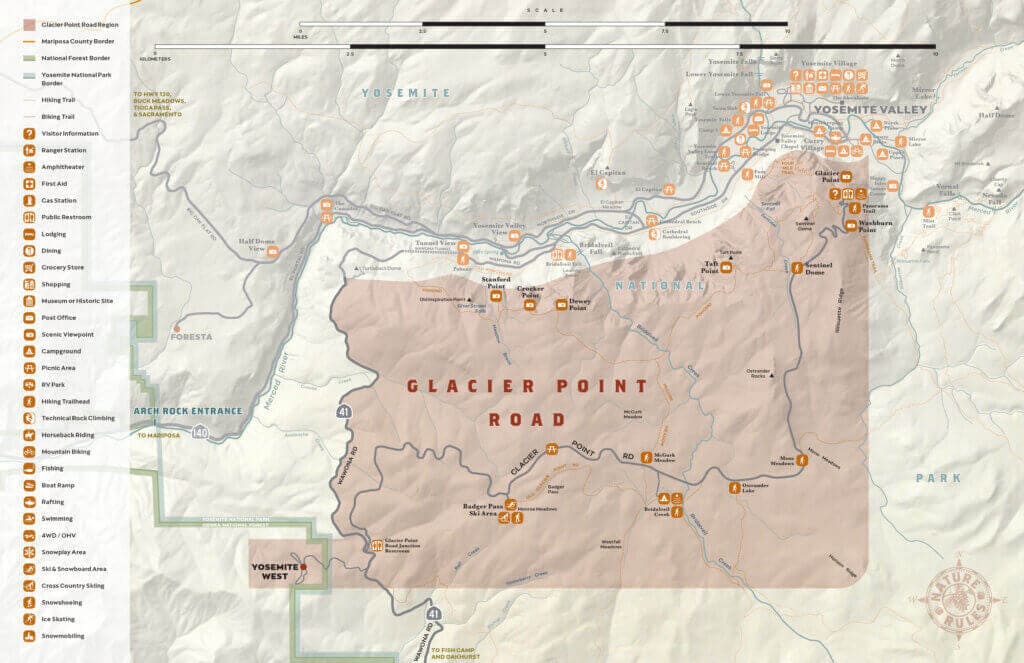
Set at the end of 16-mile Glacier Point Road, this serpentine two-lane highway follows the south rim of the Valley before arriving at the climactic Glacier Point overlook. Your reward: panoramic views of Half Dome, El Capitan, Yosemite Falls, and more from the edge of the world with Yosemite Valley some 3,200 feet straight down.
The perfect complement to the road trip: pull over and take the 2.2-mile round trip hike to Sentinel Dome – look for the Sentinel Dome/Taft Point trailhead along Glacier Point Road. Leg-stretching never felt (or looked) so good as from the top of the 8,127-ft. granite bulb of Sentinel Dome.
Day 2: Wawona and Mariposa Grove
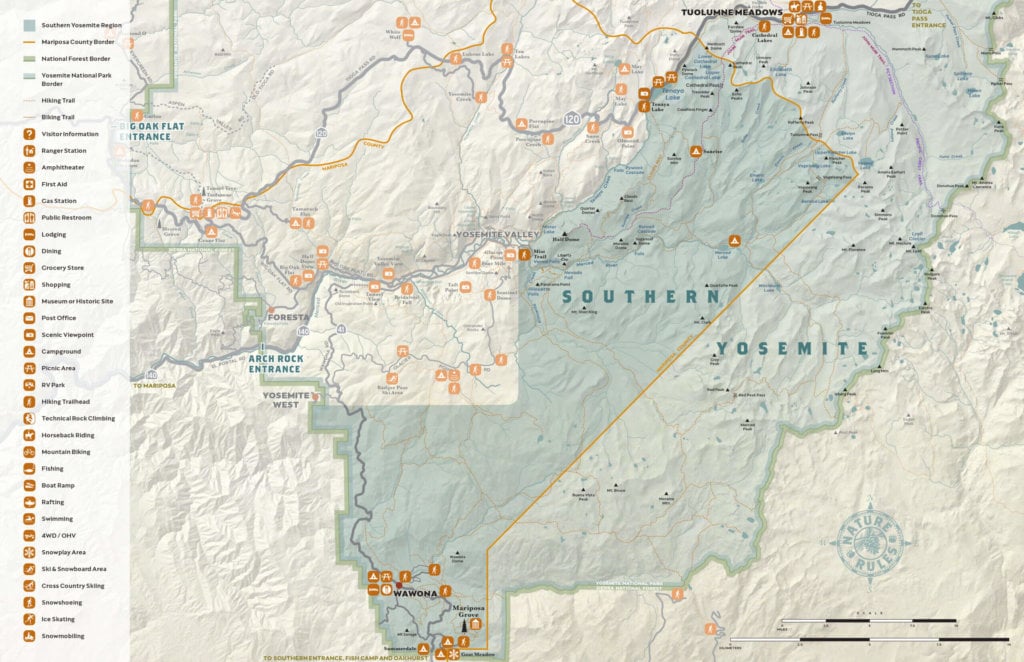
Yosemite Valley earns every prop, but the rest of this all-terrain Park is filled with places to see and things to do. Day 2 brings us to Southern Yosemite, which will fill your vacation dance card with unforgettable moments and elevate your status as a true Yosemite explorer.
Located five miles from Yosemite National Park’s South Entrance and set in a forested hollow at 4,000 feet (similar to Yosemite Valley), Wawona inspires a peaceful, easy feeling. Here, you can hike, swim, play golf, and immerse into Yosemite history. It’s no wonder the Southern Sierra Miwuk made this one of their favorite waystations to and from Yosemite Valley.
Stay in throwback mode and have lunch at the Wawona Hotel Dining Room (open March through November and over the Christmas holiday weeks). It’s a true Yosemite treasure with hearty fare served in a Victorian-era dining room with authentic ambiance. The Wawona Hotel is a historic gem and leading lodging venue in Southern Yosemite.
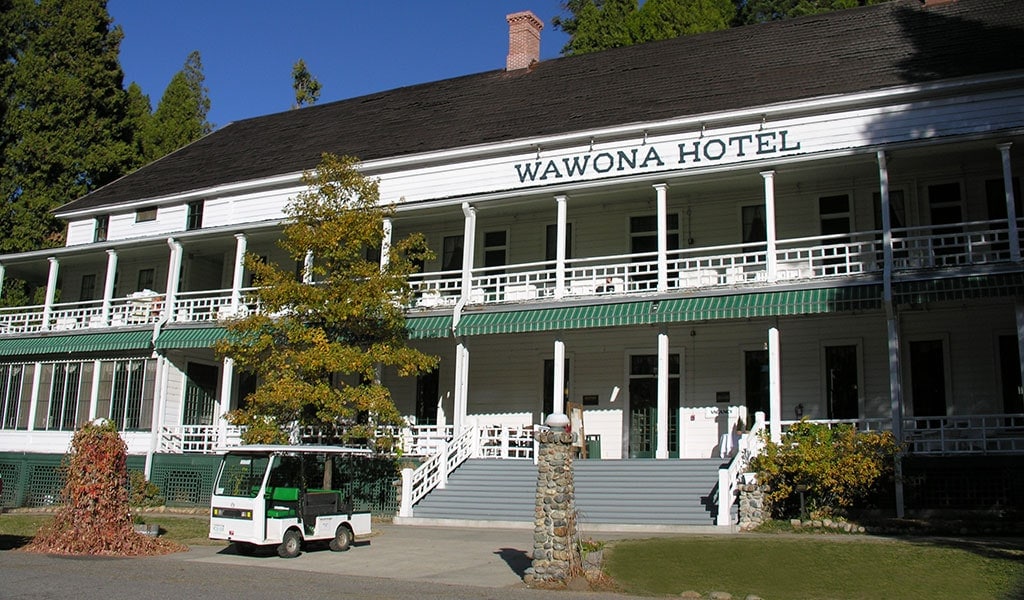
Near Wawona and next to Yosemite’s South Gate is one of Yosemite’s most awe-inspiring attractions: the Mariposa Grove of Giant Sequoias. Here you will discover more than 500 mature giant sequoia trees reaching skyward, some more than 3,000 years old and among the oldest living things on Earth. Check in to the Mariposa Grove Welcome Plaza for with maps, info, and a store with Yosemite National Park souvenirs and merch.
As the sun sets on a perfect second act, Southern Yosemite dining options include the aforementioned Wawona Hotel Dining Room and the assortment of restaurants at Tenaya at Yosemite, just a few miles down Highway 41. Tenaya is also one of the Sierra Nevada’s top family resorts and an excellent lodging choice.
Day 3: Tioga Road
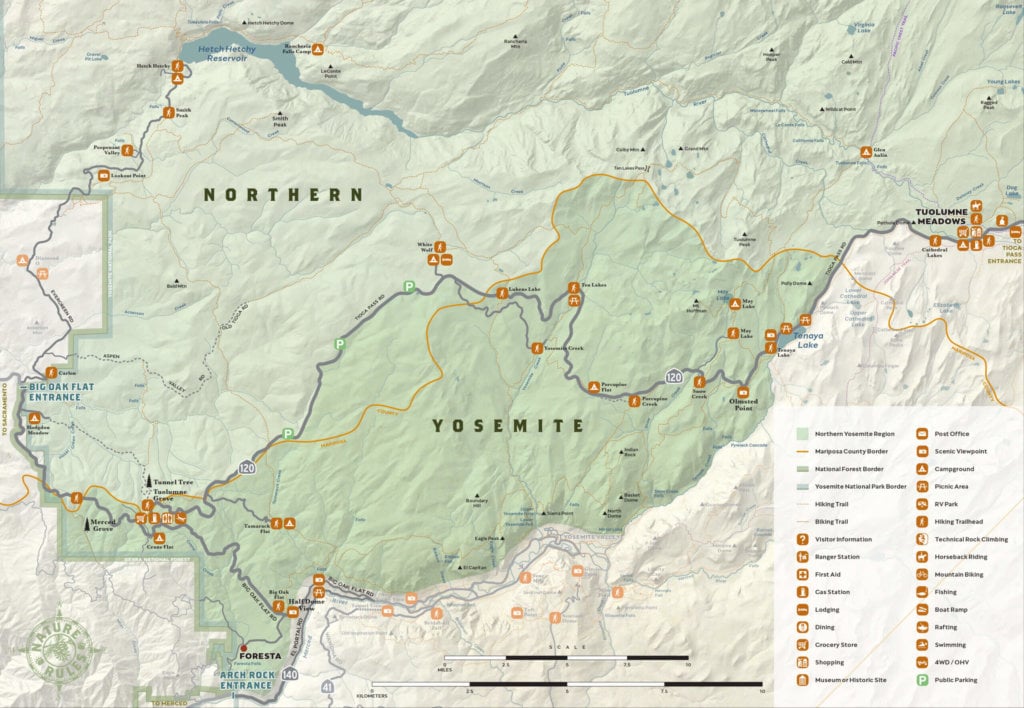
Tioga Road (Highway 120) offers jaw-dropping vistas of Northern Yosemite. There’s Olmsted Point, a large scenic overlook offering a distinct perspective to Yosemite Valley below, framing the backside of Half Dome. Take the opportunity to wander around and over the erratic boulders left here from the glacial era.
Tenaya Lake is an idyllic Sierra bowl with swimming, kayaking, and picnicking all in play. Tenaya’s postcard-pretty, clear cerulean water practically begs you to wade in. This is the largest lake in Yosemite National Park.
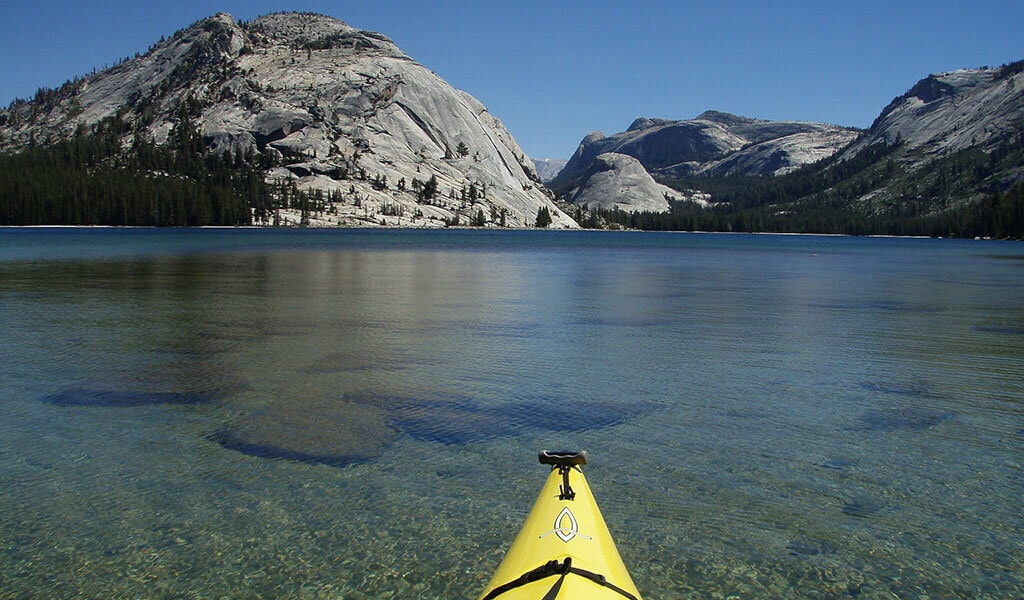
Continue to Tuolumne Meadows for one of the Sierra’s largest subalpine meadows and amenities like a Visitor Center, lodge, and café. (Please note, all facilities at Tuolumne Meadows are open only when Tioga Road is open.)
Ready to bag a Yosemite peak? Lembert Dome is a short path to big fun along Tioga Road. From the top of the dome, you’ll take in all of Tuolumne Meadows and then some. Look for the trailhead just past Tuolumne Meadows.
Try to time your return to lodging by late afternoon to catch the sunset bouncing off the granite peaks that line Tioga Road. It’s the perfect way to close a day touring Yosemite’s high country.
(Driving note: Tioga Road and Glacier Point Road are subject to seasonal closures. Check current road conditions here.)
Can’t Miss Gateway Gems
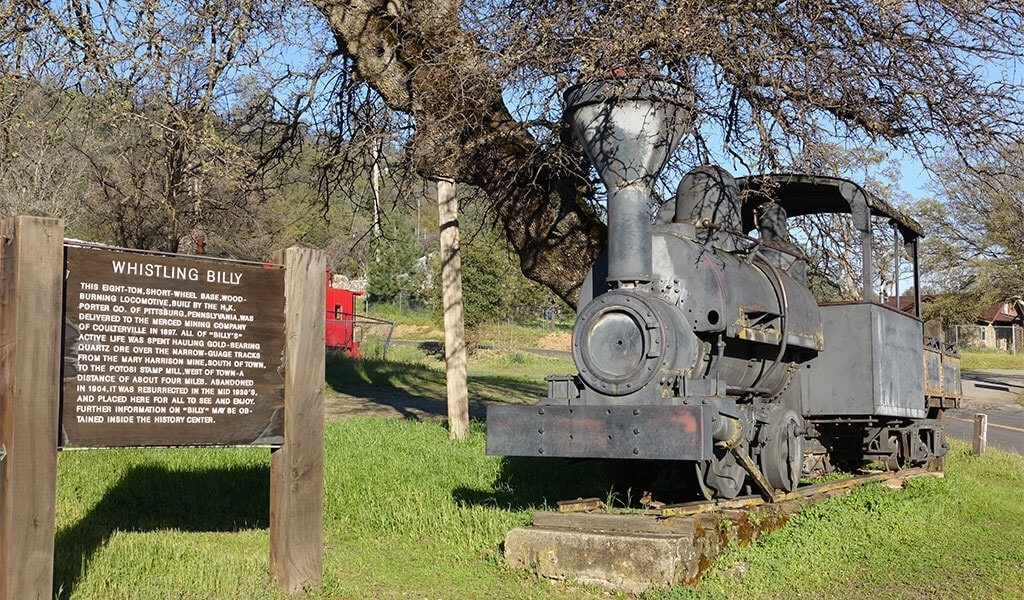
Three days is a fine amount of time to cover most of the Park’s greatest hits, and this is your roadmap to doing that. Before and after, there are a few places we suggest you stop for a beat. Yosemite’s gateway towns of Mariposa and Coulterville are laced with California history, small-town swagger, hip independent merchants, and great dining.
Astride the crossroads of Highways 49 and 140, Mariposa has Gold Rush grit running through it. It’s a jewel box lined with antique and boutique shopping, foodie-fired restaurants, tasting rooms and convivial bars, and art galleries (also where to find the greatest selection of vacation accommodations in Yosemite Mariposa County).
Just to the east on the John Muir Highway (132) at Coulterville, Bay Area-bound travelers can pull over for a perfect getaway lunch at the Coulter Café and soak in some of this tiny but mighty town’s bohemian vibes. As you take the self-guided walking tour, pop into an antique, consignment, or general mercantile shop, many housed in original structures dating to the mid-1800s.
Coming & Going
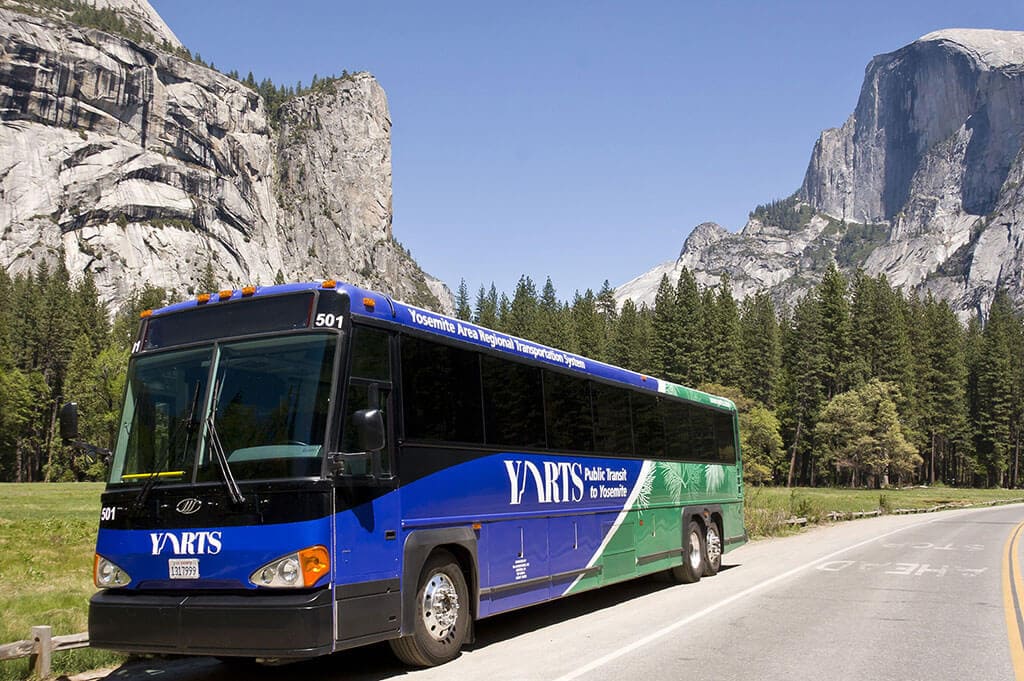
Yosemite is just a scenic half-day drive from the San Francisco Bay Area and greater Los Angeles with many modes of transportation on offer. Most travelers to Yosemite Mariposa County arrive on one of three California state highways: Highway 41 from the south, and Highways 120 and 140 from the northeast.
Fresno International Airport (FAT) is the closest to Yosemite; additional California international gateway airports are less than a half day’s drive away. Amtrak, America’s national rail system, also serves Yosemite from most major California cities. Finally, the Park region offers an excellent network of public transportation: YARTS to the Park, and the Yosemite Shuttles once you’re here.
The Ultimate Guide for First-Timers
With just a little planning and preparation, you can make the most of your time and create indelible Yosemite memories! The Yosemite Vacation Planner will get you started with our exclusive insider tips and ideas on things to do in Yosemite Mariposa County. Download the guide to your digital device to keep it handy throughout your visit.

